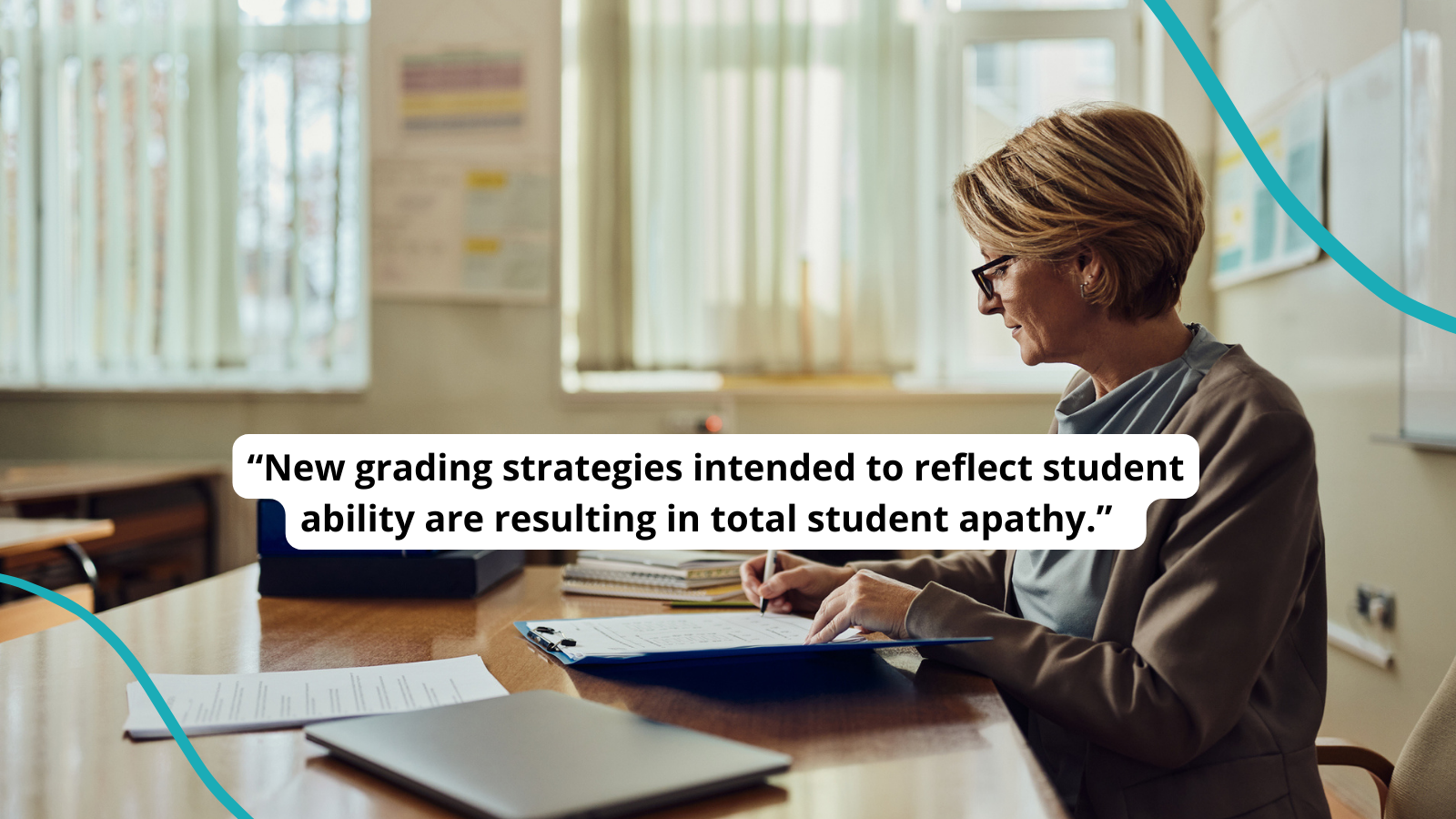Miss Penrod gently rested her head on her desk in defeat. A huge stack of graded summative assessments lie beside her; a range of grades but mostly failures. Why was this continuing to happen? Why were her students not practicing the work before it was time to demonstrate what they knew on the test? After 17 years in education, this behavior was just now being displayed, and only after implementing new district-wide grading policies.
In education, change is inevitable. Sometimes, innovative initiatives lead to success, while others encounter unexpected challenges. Sometimes, these unexpected challenges come from an underdeveloped policy layout, even if the intentions behind the policy are good. This was Laura Jeanne Penrod’s experience as the school system she worked for, Clark County School District in Nevada, attempted to implement equitable-grading practices.
What does equitable grading really mean?
Accurate, bias-resistant, and motivational grading practices are the core of Joe Feldman’s Grading for Equity work. Here are some examples of practices many schools have adopted in moving toward grading equity:
- Avoiding zeros on the 0-100-point scale and implementing a 50 in place as the minimum grade
- Standards-based grading practices
- Letting a student’s most recent retake grades replace former grades as new evidence of learning
- No late points taken off—work is graded on standards
- Giving non-grade consequences for cheating and excluding participation and effort from the grade
- And giving feedback remarks as grades as opposed to any points or letter scales
The goal is to let teachers reflect on their current grading practices and how they could be harming traditionally underperforming groups. He and other grading reformers argue grades should only reflect student abilities inside the classroom, not reflect their disadvantages outside the classroom.
The intention behind these practices is one all teachers can get behind. No teacher wants to be unfairly putting kids at a disadvantage with the way they grade, and it makes sense that districts would rush to adopt these measures. But unfortunately, whether they actually help kids hasn’t yet been proven by research.
When new policies and reform efforts are passed down to teachers without proper training and support, it can do more harm than good. We Are Teachers sat down with Penrod to discuss the lessons learned in making the shift to equitable grading practices.
How did your district implement these equitable grading practices?
CCSD decided (pre-pandemic) to work on incorporating equitable grading practices by 2024 when Dr. Jesus Jara took over as superintendent in 2018. The focus was on student success, and fair grading practices became part of that goal. Students were receiving credit even without mastering the content, or being penalized for behaviors attached to their grades (losing points for late work, extra credit for school supplies, etc.).
The district decided to focus on standards-based grading and equitable grading practices, thinking it would allow students to learn and succeed without interference from external circumstances. In other words, be on a more level playing field. In theory, this is a great plan.
What was the implementation like?
The district began implementing these practices after students returned from the virtual 2020-2021 year during COVID.
While the intention for these grading practices was noble, the initial rollout lacked proper training and preparation. Teachers received prerecorded, asynchronous online sessions in July to understand the rationale, but there was zero insight into what the daily practices would look like in our classrooms.
We came away assuming formative assessments were 0% of a student’s grade and summative assessments would be 100%. It was like we were flying the plane while building it.
What were some of the positive aspects of these grading changes?
There were definitely benefits, such as allowing students to retake assessments and focusing on content mastery rather than behaviors. Also, students saw eliminating extra credit and not tying behavior to academics as positive steps.
What challenges emerged from the new grading policies?
One of the biggest challenges was allowing students to turn in late work for extended periods, leading to apathy and a lack of urgency.
With such a heavy weight placed on summative assessments, the policy also caused an unexpected increase in student testing anxiety.
Students didn’t find any value in doing assignments that only weighted 10% of their final grade. Some students wouldn’t complete homework or daily work and then wonder why they didn’t do well on assessments or timed writes. Since they weren’t practicing on their formative assessments, they weren’t prepared for their summative assessments.
Additionally, students started gaming the system when they learned they could earn 50% for no work done, fostering a lack of motivation.
Finally, students who actually needed the extensions and retakes weren’t taking advantage of them.
How did the district address these challenges and move forward?
I was on a panel with our superintendent in March of 2022. After that, I set up a monthly meeting with him and a roundtable of teachers to discuss our concerns about equitable grading and other issues. On top of my advocacy, op-eds, and other roundtables and admin feedback, they have updated and changed some policies this year. They got rid of the 50% minimum for grades and set a limit for late work of five days. Also, there are now requirements for communication with students’ families about missing assignments and plans for remediation. There is more required of students now in terms of completing work, but also in terms of planning and reflecting.
There is no new professional development for these grading practices, though. Our district’s PD revolves around learning outcomes, tier-one instruction, and student success criteria. Yet we don’t have a single PD on grade reform. If and when policies change, there’s no real training or pilot period for us to adjust to the new practices.
The good news is that the biggest roadblock for student motivation—no grades below a 50—was eliminated. We will only round grades up at the quarter to 50%. This gives students the ability to still pass the semester.
Could proper professional development have made a difference?
Absolutely. The 50% and equitable grading are two different entities. Teaching kids they don’t need to do anything to earn half credit didn’t make things more equitable.
The goal is to get to the 0-4-point grading scale. We just haven’t gotten there yet because I feel like they are throwing the kitchen sink at teachers this year due to COVID “learning loss.” Inadequate training kept us from grading equitably, especially after COVID-19 when students questioned the value of school or schoolwork. We need more professional development around the why and how of these practices. It takes time and repetition/practice.
We should have had a whole year learning how to implement this. Our teachers needed time to develop our lessons differently, etc., and plan how to meet our students’ needs under this policy. The district still hasn’t given us that time, but if we had had time to assess, practice, and learn that and roll it out slowly vs. a blanket mandate, it could have gone smoother and had the bugs fixed more closely than what happened.
We also needed input, which didn’t happen until after it affected teachers, students, families, and the community. We have created kids who don’t “care” about their work. This could’ve worked or been better in many ways, but now we are backtracking and trying to fix it again. The back and forth is not beneficial for anyone. It is exhausting for us and our families to keep up with all the changes.
The takeaway: Reform needs support.
Change is a constant companion for teachers, and it’s not that they oppose change or new policies. New initiatives and reforms can hold potential, offering solutions to age-old problems. However, as Penrod’s experience highlights, the success of these endeavors hinges on the preparation and support provided to the educators who are tasked with implementation.
As we discussed last spring, the concept of equitable-grading practices carries noble intentions for grading disadvantaged students more accurately. Yet, its assimilation and execution necessitate a transitional period of three to five years for a seamless shift. An entire reform to traditional grading practices requires comprehensive training, thoughtful piloting, and ongoing support to ensure their execution. Let’s not forget that the heart of the matter lies with the educators who shape the classroom experiences of our students. With the right training, teachers can transform equitable-grading practices into grading that truly benefits both educators and students.
For more articles like this, be sure to subscribe to our newsletters.


